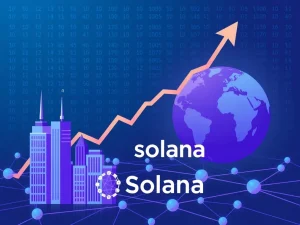Revolutionary AI Cryptos: US AI Strategy Ignites Fetch.ai, Bittensor, Render Interest

The world of cryptocurrency is constantly evolving, and few sectors are buzzing louder than those at the intersection of blockchain and artificial intelligence. Recent moves by the U.S. government to prioritize AI have sent ripples through the crypto market, drawing significant attention to key AI Cryptocurrencies. If you’re invested in the future of decentralized tech, understanding this synergy is crucial.
The US AI Strategy: A Catalyst for AI Cryptocurrencies?
The U.S. government’s recent launch of AI.gov on July 23 marks a significant step in solidifying artificial intelligence as a national strategic priority. This centralized platform aims to streamline innovation, infrastructure development, and global standards-setting in AI. This proactive stance is designed not only to foster domestic growth but also to counter international competition, especially in sectors where AI and blockchain converge. As a direct consequence, AI Cryptocurrencies have garnered renewed investor interest, with several projects emerging as focal points in this evolving landscape.
The White House’s comprehensive US AI Strategy, outlined on AI.gov, includes measures like deregulation to accelerate AI development and significant infrastructure projects, such as data center construction. These initiatives are poised to directly benefit AI-focused crypto projects by reducing regulatory friction and expanding access to vital resources. While short-term price fluctuations are common, the long-term trajectory of these tokens is increasingly linked to their ability to integrate with federal AI initiatives and demonstrate scalable real-world use cases.
Fetch.ai (FET): Powering Decentralized AI Ecosystems
Among the leading projects capturing investor attention is Fetch.ai (FET). Positioned as a key player in the Artificial Superintelligence Alliance, which includes collaborators like Ocean Protocol and SingularityNET, Fetch.ai is driving the vision of Artificial General Intelligence (AGI). This ambition aligns perfectly with the White House’s emphasis on transformative technologies.
- Current Snapshot: At $0.737, FET saw a 0.98% decline in 24 hours.
- Market Strength: Its substantial $1.78 billion market cap and $189.55 million trading volume indicate sustained institutional engagement.
- Core Utility: FET’s relevance stems from its role in decentralized AI data ecosystems, facilitating machine learning networks—a utility that resonates with federal priorities for data and AI infrastructure.
Bittensor (TAO): The Brain Behind Decentralized Machine Learning
Another project making waves is Bittensor (TAO), which uniquely operates at the intersection of blockchain and machine learning. Bittensor enables the decentralized training of AI models, allowing users to contribute computational resources to the network. Contributors are rewarded in TAO tokens based on the value of their contributions, creating a truly collaborative AI development environment.
- Market Dynamics: Priced at $420.75, TAO experienced a 2.54% drop in 24 hours, reflecting both speculative demand and its functional role in data-sharing infrastructure.
- Active Participation: The project’s 10.59% trading volume-to-market cap ratio highlights active participation, suggesting a strong alignment with government-driven AI infrastructure goals that seek to leverage distributed computing power.
Render Token (RENDER): Fueling the Future of Digital Creation
The Render Token (RENDER) addresses a critical need in the AI and graphics-intensive sectors: computational power. By connecting users with idle GPU resources, Render facilitates high-demand tasks such as rendering, animation, and AI model training. This decentralized approach democratizes access to powerful computing, a vital component for digital innovation.
- Market Position: At $4.01 and down 2.84% in 24 hours, RENDER’s market position is bolstered by its clear use case in digital content creation, a sector poised for significant growth under the U.S. AI expansion.
- Industry Adoption: RENDER’s consistent ranking as a top AI-linked coin in recent months underscores its adoption in industries where decentralized computing power is essential for rapid development and scalability.
Navigating the Future: Opportunities and Challenges for AI Cryptos
The interplay between policy, technological advancement, and market dynamics suggests that AI Cryptocurrencies like FET, TAO, and RENDER will remain under intense scrutiny. The proactive US AI Strategy, with its focus on deregulation and infrastructure, presents a significant tailwind for these projects, potentially lowering barriers to entry and expanding access to crucial resources. However, the path forward is not without its complexities.
Critics caution that the rapid integration of AI and blockchain introduces inherent risks, including ethical concerns, data privacy challenges, and system vulnerabilities. Ensuring robust security and responsible development will be paramount. Conversely, proponents argue that the U.S. must prioritize innovation to maintain global leadership, particularly as AI becomes a cornerstone of economic and national security strategies. The long-term success of these AI-linked tokens will ultimately hinge on their ability to demonstrate scalable use cases, foster real-world adoption, and navigate the evolving regulatory landscape with clarity and adaptability.
The current price swings for Fetch.ai, Bittensor, and Render are typical market fluctuations. However, the underlying narrative—a strong governmental push for AI innovation—provides a compelling backdrop for their future. As the U.S. doubles down on AI, the decentralized solutions offered by these projects could play a pivotal role in shaping the next generation of intelligent systems, making them crucial assets to watch for any crypto enthusiast.
Frequently Asked Questions (FAQs)
What is the significance of AI.gov for AI Cryptocurrencies?
AI.gov, launched by the U.S. government, signifies a national strategic priority on AI. This centralized platform aims to streamline AI innovation and infrastructure development, which can reduce regulatory friction and expand resources for AI-focused crypto projects like Fetch.ai, Bittensor, and Render.
How do Fetch.ai (FET), Bittensor (TAO), and Render Token (RENDER) relate to AI?
Fetch.ai (FET) focuses on decentralized AI data ecosystems and multi-agent systems for AGI. Bittensor (TAO) enables decentralized training of AI models, rewarding contributors for computational resources. Render Token (RENDER) provides decentralized GPU computing power for AI rendering and graphics-intensive tasks.
What are the potential benefits for AI Cryptocurrencies from the US AI Strategy?
The US AI Strategy could lead to deregulation, increased funding for AI infrastructure (like data centers), and a broader embrace of AI technologies. These factors could foster a more favorable environment for AI-linked cryptos, driving adoption and integration into mainstream applications.
Are there risks associated with the rapid integration of AI and blockchain?
Yes, critics point to potential risks such as ethical concerns regarding AI development, data privacy issues, and system vulnerabilities inherent in rapidly evolving technologies. Balancing innovation with robust security and responsible governance is a key challenge.
Why are Fetch.ai, Bittensor, and Render considered focal points among AI Cryptos?
These three projects represent distinct yet crucial aspects of decentralized AI: Fetch.ai with its agent-based systems, Bittensor with its decentralized machine learning, and Render with its distributed computing power. Their clear use cases and alignment with broader AI development goals make them prominent in the current market.
What should investors consider when looking at AI Cryptocurrencies?
Investors should consider the project’s real-world utility, its integration potential with broader AI initiatives (including government strategies), the strength of its ecosystem, and its ability to demonstrate scalable use cases beyond speculative demand. Long-term success depends on tangible adoption and technological advancement.








